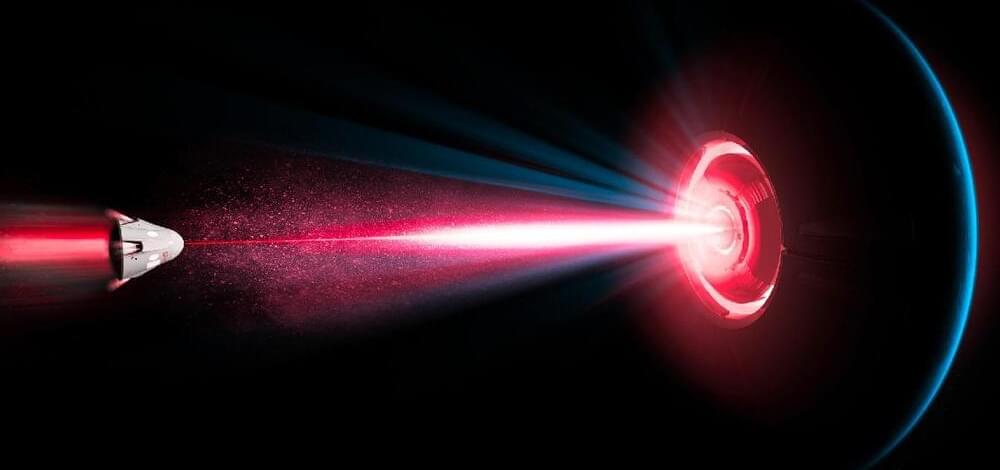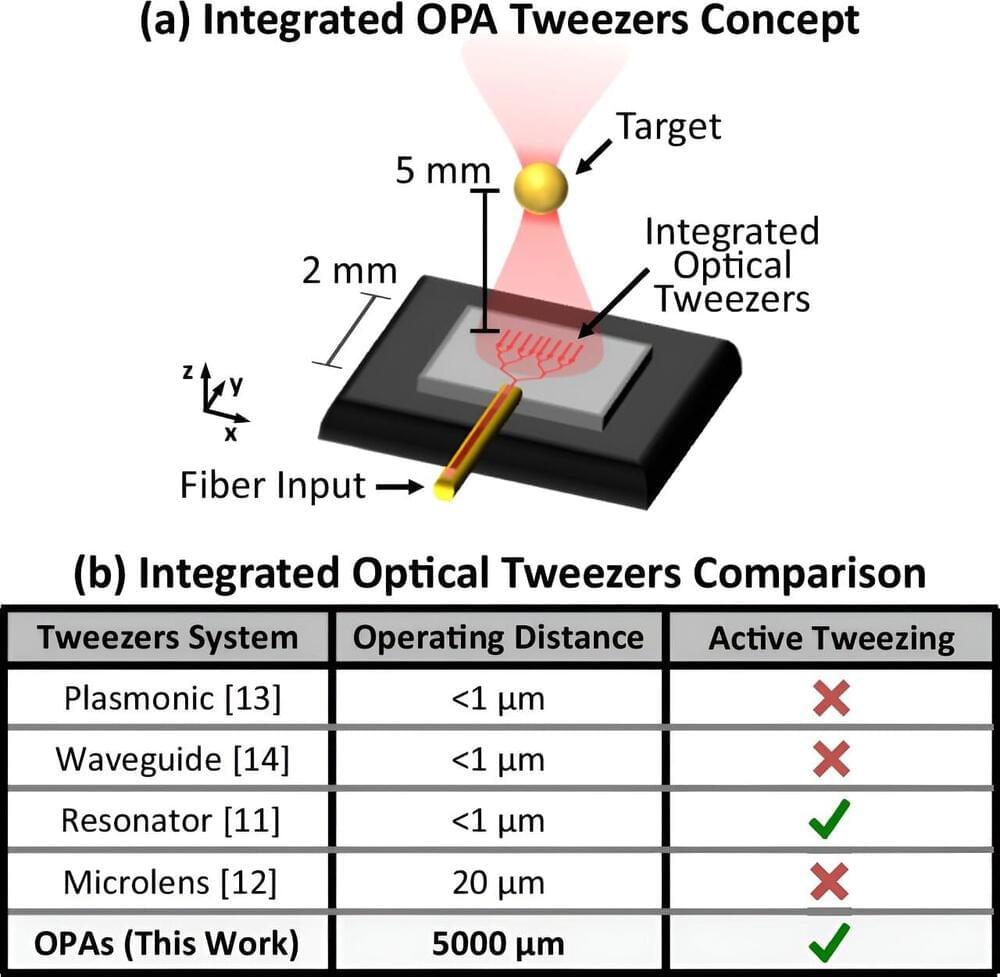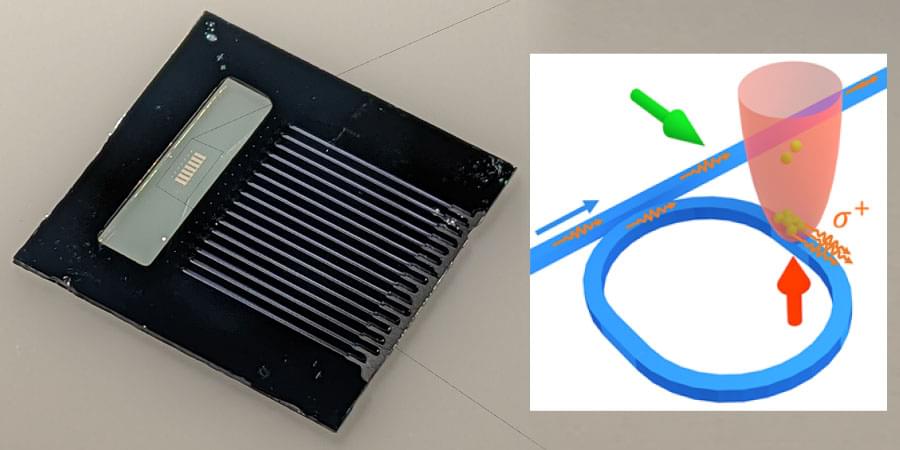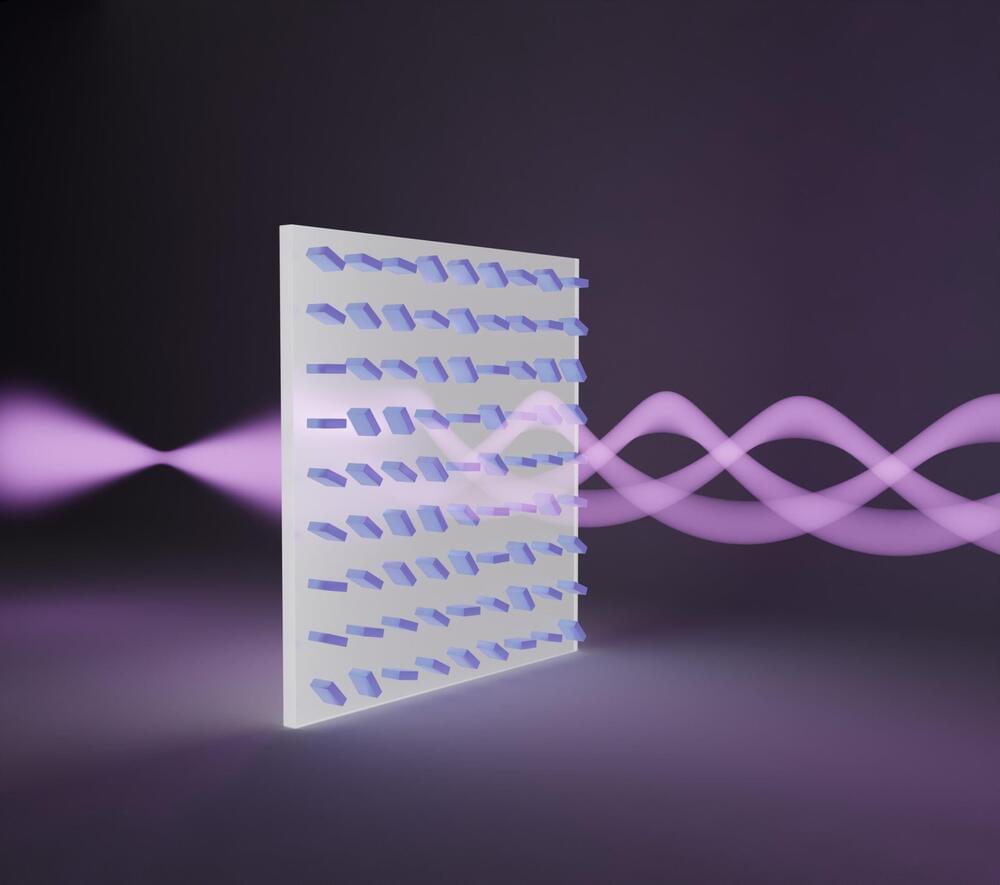Laser-generated pulling forces are over 1,000 times stronger than those driving solar sails.
Category: tractor beam
MIT researchers have developed a miniature, chip-based “tractor beam,” like the one that captures the Millennium Falcon in the film “Star Wars,” that could someday help biologists and clinicians study DNA, classify cells, and investigate the mechanisms of disease.
Small enough to fit in the palm of your hand, the device uses a beam of light emitted by a silicon-photonics chip to manipulate particles millimeters away from the chip surface. The light can penetrate the glass cover slips that protect samples used in biological experiments, enabling cells to remain in a sterile environment.
Traditional optical tweezers, which trap and manipulate particles using light, usually require bulky microscope setups, but chip-based optical tweezers could offer a more compact, mass-manufacturable, broadly accessible, and high-throughput solution for optical manipulation in biological experiments.
Chip-based tractor beam Integrated optical tweezers use an intensely focused beam of light to capture and manipulate biological particles without damaging the cells.
Optical manipulation techniques are garnering increased interest for biological applications.
Optical manipulation techniques are garnering increased interest for biological applications. Researchers from Massachusetts Institute of Technology (MIT) have now developed a miniature, chip-based optical trap that acts as a “tractor beam” for studying DNA, classifying cells and investigating disease mechanisms. The device – which is small enough to fit in your hand – is made from a silicon-photonics chip and can manipulate particles up to 5 mm away from the chip surface, while maintaining a sterile environment for cells.
The promise of integrated optical tweezers
Integrated optical trapping provides a compact route to accessible optical manipulation compared with bulk optical tweezers, and has already been demonstrated using planar waveguides, optical resonators and plasmonic devices. However, many such tweezers can only trap particles directly on (or within several microns of) the chip’s surface and only offer passive trapping.
MIT researchers have developed a miniature, chip-based “tractor beam,” like the one that captures the Millennium Falcon in the film “Star Wars,” that could someday help biologists and clinicians study DNA, classify cells, and investigate the mechanisms of disease.
Small enough to fit in the palm of your hand, the device uses a beam of light emitted by a silicon-photonics chip to manipulate particles millimeters away from the chip surface. The light can penetrate the glass cover slips that protect samples used in biological experiments, enabling cells to remain in a sterile environment.
Traditional optical tweezers, which trap and manipulate particles using light, usually require bulky microscope setups, but chip-based optical tweezers could offer a more compact, mass manufacturable, broadly accessible, and high-throughput solution for optical manipulation in biological experiments.
Traditional optical tweezers, which trap and manipulate particles using light, usually require bulky microscope setups, but chip-based optical tweezers could offer a more compact, mass manufacturable, broadly accessible, and high-throughput solution for optical manipulation in biological experiments.
However, other similar integrated optical tweezers can only capture and manipulate cells that are very close to or directly on the chip surface. This contaminates the chip and can stress the cells, limiting compatibility with standard biological experiments.
Using a system called an integrated optical phased array, the MIT researchers have developed a new modality for integrated optical tweezers that enables trapping and tweezing of cells more than a hundred times further away from the chip surface.
Researchers at Purdue University have trapped alkali atoms (cesium) on an integrated photonic circuit, which behaves like a transistor for photons (the smallest energy unit of light) similar to electronic transistors. These trapped atoms demonstrate the potential to build a quantum network based on cold-atom integrated nanophotonic circuits. The team, led by Chen-Lung Hung, associate professor of physics and astronomy at the Purdue University College of Science, published their discovery in the American Physical Society’s Physical Review X (“Trapped Atoms and Superradiance on an Integrated Nanophotonic Microring Circuit”).
“We developed a technique to use lasers to cool and tightly trap atoms on an integrated nanophotonic circuit, where light propagates in a small photonic ‘wire’ or, more precisely, a waveguide that is more than 200 times thinner than a human hair,” explains Hung, who is also a member of the Purdue Quantum Science and Engineering Institute. “These atoms are ‘frozen’ to negative 459.67 degrees Fahrenheit or merely 0.00002 degrees above the absolute zero temperature and are essentially standing still. At this cold temperature, the atoms can be captured by a ‘tractor beam’ aimed at the photonic waveguide and are placed over it at a distance much shorter than the wavelength of light, around 300 nanometers or roughly the size of a virus. At this distance, the atoms can very efficiently interact with photons confined in the photonic waveguide. Using state-of-the-art nanofabrication instruments in the Birck Nanotechnology Center, we pattern the photonic waveguide in a circular shape at a diameter of around 30 microns (three times smaller than a human hair) to form a so-called microring resonator. Light would circulate within the microring resonator and interact with the trapped atoms.”
A key aspect function the team demonstrates in this research is that this atom-coupled microring resonator serves like a ‘transistor’ for photons. They can use these trapped atoms to gate the flow of light through the circuit. If the atoms are in the correct state, photons can transmit through the circuit. Photons are entirely blocked if the atoms are in another state. The stronger the atoms interact with the photons, the more efficient this gate is.
Researchers at TMOS have developed a metasurface-enabled solenoid beam that can pull particles towards it, potentially revolutionizing non-invasive medical procedures like biopsies. This technology, which uses a thin layer of nanopatterned silicon, offers a lightweight, portable alternative to the bulky equipment previously required for such beams. Credit: University of Melbourne.
Researchers at TMOS, the ARC Centre of Excellence for Transformative Meta-Optical Systems, have made a significant initial advancement in creating tractor beams enabled by metasurfaces. These beams of light, capable of drawing particles towards them, are inspired by the fictional tractor beams seen in science fiction.
In research published in ACS Photonics, the University of Melbourne team describes their solenoid beam that is generated using a silicon metasurface. Previous solenoid beams have been created by bulky special light modulators (SLMs), however, the size and weight of these systems prevent the beams from being used in handheld devices. The metasurface is a layer of nanopatterned silicon only about 1/2000 of a millimeter thick. The team hopes that one day it could be used to take biopsies in a non-invasive manner, unlike current methods such as forceps that cause trauma to the surrounding tissues.
Researchers at TMOS, the ARC Center of Excellence for Transformative Meta-Optical Systems, have taken an important first step in the development of metasurface-enabled tractor beams—rays of light that can pull particles toward it, a concept that fictional tractor beams featured in science fiction are based on.
Warping Reality
Posted in space travel, tractor beam
The goal of science is to understand and master the Universe around us, but could our skill grow so great that we could learn to warp reality itself?
Visit our Website: http://www.isaacarthur.net.
Join Nebula: https://go.nebula.tv/isaacarthur.
Support us on Patreon: / isaacarthur.
Support us on Subscribestar: https://www.subscribestar.com/isaac-a…
Facebook Group: / 1583992725237264
Reddit: / isaacarthur.
Twitter: / isaac_a_arthur on Twitter and RT our future content.
SFIA Discord Server: / discord.
Listen or Download the audio of this episode from Soundcloud: Episode’s Audio-only version: / warping-reality.
Episode’s Narration-only version: / warping-reality-narration-only.
▬ Reality Warping Concepts ▬▬▬▬▬▬▬▬▬▬
0:00 Intro.
2:06 Warping Spacetime.
4:58 Negative Mass.
5:25 Spaceship Propulsion.
8:41 Forcefields \& Shields.
11:07 Reversing Universal Expansion.
12:17 Matter Creation.
12:49 Super Strong Materials.
14:14 Cloaking.
15:17 Hammerspace.
19:07 Tractor Beams.
20:11 Time Manipulation \& Stasis.
24:20 Ultra-fast Communication.
25:08 Vacuum Energy.
25:48 Universe Creation.
26:40 Probability Manipulation \& Luck.
27:47 Perpetual Civilizations.
Credits:
Warping Reality.
Science \& Futurism with Isaac Arthur.
Episode 396, May 26, 2023
Written, Produced \& Narrated by Isaac Arthur.
Editors:









